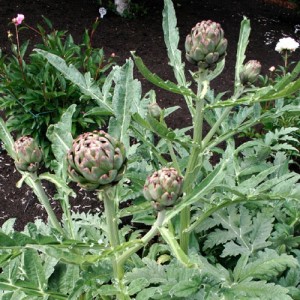Rust and Leaf-curl on Artichoke Leaves
 Question from Niel:
Question from Niel:
I have an artichoke plant that quite recently showed some rust with tiny white spots inside. Also,some of the leaves are curling backwards on themselves. Do you know of any in-home remedies I can get rid of it with or do I go commercial and get something at the nursery?
Answer from Pat:
I don’t recommend you spray your artichoke plant since I can’t figure out from your description what is afflicting it. If you read through all the information I am providing here you may find your solution within these suggestions. Artichokes are subject to a few diseases but the problem you have described doesn’t seem to fit the description of any of them except cold damage. If your garden was subjected to freezing temperatures that might explain the problem. Here are the main diseases of artichokes and problems with artichokes:
- Cold damage: White blisters and black streaks occur on the leaves of the flower (bud scales of the flower bud.) This usually happens only after the plant has been subjected to freezing temperatures. The discoloration appears during the day after a freezing night. Next time whenever frost is expected cover the plant with burlap or sheets during the night. The bud is still edible or if badly damaged just cut off the bad bits.
- Slugs and snails: These leave white trails and scars that may go brown. (Solution is provided below.)
- Artichoke plum moth: These lay eggs at night and then the larvae hatch and cause irregular holes in the leaves and fruit. This is seldom a problem in home gardens but in large fields must be controlled by an insecticide. In home gardens apply Spinosad to control if necessary.
- Curly dwarf disease: This dwarfs the plant and stunts growth. It is a viral disease transmitted by leaf hoppers and aphids but there is no known cure. Best defense is to keep a steady population of ladybugs living in your garden to destroy all aphids and control ants by surrounding the plant with a layer of dry earthworm castings.
Success with artichokes in home gardens usually comes from growing them as correctly as possible. The main things are these: Grow artichokes in the ground or in raised beds, not in containers unless they are at least the size of a half-barrel and even that is a bit small. Secondly artichokes need full sun, not shade. (Trying to grow an artichoke in shade can lead to disease problems, such as mildew and perhaps rust, though I have never heard of rust on an artichoke.) Third provide regular irrigation. Always water artichokes deeply and well at least once a week, but they must have good drainage and never be raised in a swamp. And finally artichokes need adequate fertilizer for rapid growth. (Curled leaves can be a sign of insufficient irrigation. A hot spell can also cause curled leaves.)
The other tricks are to pull off and remove suckers except for four surrounding the central stem and to protect from snails by handpicking or by applying a bait such as Sluggo to the ground surrounding the plant. Occasionally I have heard of earwigs afflicting artichokes and my recommendation is to trap them in moist rolled newspapers, placing these under the plants at night and discarding them in the early morning with the earwigs inside.


thank-you for your timely response to my e-mail.I printed it out and will keep it for future reference. Thanks again